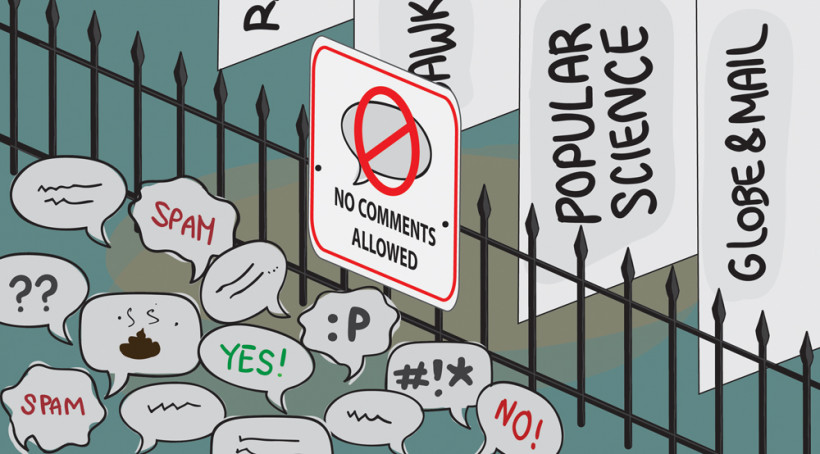Two Cents and Trolls
You’ll probably have some opinions by the end of this article.
Keep them to yourself.
That was the impression Popular Science magazine gave its readers after announcing last September it would close the comments section of its website. Opening her editorial with “Comments can be bad for science,” then-digital editor Suzanne LaBarre explained that “trolls” were counterproductive to the magazine’s work.
“Even a fractious minority wields enough power to skew a reader’s perception of a story,” she wrote.
Popular Science, of course, is in the minority—most publications out there actively seek readers’ feedback. Radio-Canada.ca’s online comment section has been up on the entire site since May 2009.
The website’s digital news director, Pierre Champoux, sees the section as a “commitment […] to hear what’s on Canadians’ minds.” Behind this PR-like answer, though, lies a desire to change a flaw associated with old-style journalism.
“Our television and radio reporters used to work in prescription mode,” Champoux added. “We told people, ‘Here’s what you should know […],’ but we didn’t expect to hear back from them.
“With time, our reporters have discovered interaction can be a good thing,” he continued. “They used to be afraid of being criticized.”
For big publications, creating space for readers to give their two cents can be a costly ordeal, but none of the organizations that were asked about the cost associated with curating comments gave any figures, citing business reasons.
Some organizations gave a clearer picture of how costly an endeavour comment curation can be, however. According to the Huffington Post, the website employs “the equivalent of about 30 full-time moderators [who] work 24/7/365 in six-hour shifts going through hundreds of comments per hour” according to an interview with Poynter.
The New York Times has three full-time moderators and 10 part-timers. Champoux estimates two moderators go through Radio-Canada.ca’s online comments each hour.
The Montreal Gazette, meanwhile, relies on its readers to oversee the website’s postings.
“We trust the community to flag us. We’re not moderating as much as we’re monitoring the conversation. If it goes off track we’ll step in,” said Mick Côté, the paper’s digital editor.
“Step in” entails a comment being flagged and someone, usually Côté, making the call as to whether or not the post should be taken down.
While Popular Science may be an anomaly when it comes to shutting out comments entirely, its qualms no less epitomize the difficulties involved in carrying such a section.
In 2012, Gawker changed its commenting policy. Like LaBarre, Gawker founder Nick Denton, too, wanted to keep trolls at bay. Would-be commenters could either register with Gawker’s in-house “account option,” dubbed “Burner,” or log in through their Twitter, Google or Facebook account.
The Gazette resorted to a similar solution over a year ago by requiring readers to log in from their Facebook account to comment on online stories.
“The previous platform we used allowed for anonymous commenting. Since switching over to Facebook, we’ve noticed a drop in trolling and inappropriate comments,” said Côté.
Radio-Canada knows a thing or two about inappropriate.
“During the 2012 Quebec elections, Option Nationale—which is not a major party—was the most efficient on social media,” said Champoux. “I spent an entire evening on Facebook after someone from the party called me out, saying we weren’t covering the party the way we should.
“Various people throughout Radio-Canada were inundated with dozens of what seemed to be copy-pasted messages,” he continued. “It was clearly the work of some commando who was following the orders coming from social media or someone from the party.”
To avoid such conundrums, in March 2011, National Public Radio implemented a policy based on a trial period in which comments made by new users are “reviewed by a community manager prior to the comments appearing on the site,” according to an editorial the radio network published on its website.
Then there are times when the section has to be closed altogether for certain articles. Aside from issues related to offensive content, there are also those tied to potential legal ramifications.
Sylvia Stead, the Globe and Mail’s public editor, felt the wrath of her readers when the newspaper’s website closed comments for a certain Rob Ford article.
“The reason for closing in these cases is to avoid contempt of court, which ensures that all individuals have a right to a fair trial and that right should not be impaired by pre-trial statements or statements during a trial,” she told The Link. “Our reporters and editors are well trained in what can be printed in legal cases, while members of the public are unaware of the legal principles and rules for criminal cases.”
While having comments on one’s website may sound like an all-expenses-paid trip to a guaranteed migraine, these opinions may actually have a direct impact on reporters’ work, says Champoux.
“A few times we managed to get in touch with people [who commented] and sometimes it enhanced a piece. But we don’t do it enough,” he said.
Many reporters, already burdened by their publication’s requirement to use social media on top of carrying out their main duties, would likely gasp at the idea of adding yet another task to the list—especially after a cost-benefit analysis of such an effort.
At best, comment sections require many resources for very little tangible returns; at worst, they can be thorny and filled with nonsense. This ambivalence is not lost on Champoux.
“We know there’s an element of risk carrying comment sections, but it’s interesting for us, as journalists, to see what moves people and find out what aspects of our coverage we could elaborate on accordingly,” he said.





_600_375_90_s_c1.jpg)
